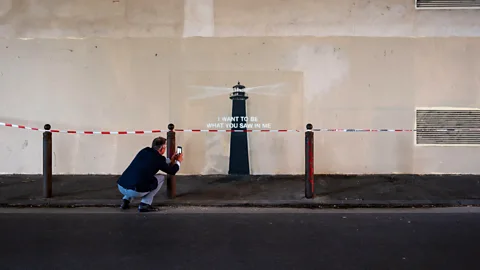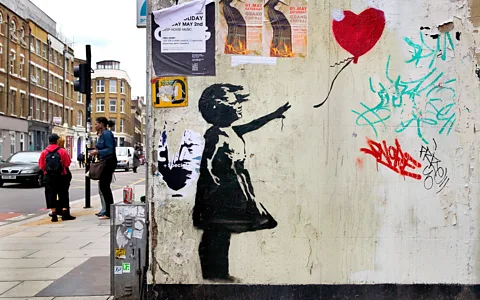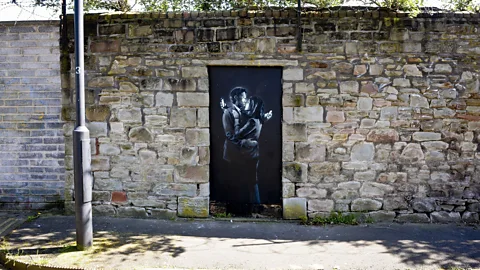Five works that reveal the philosophy of Banksy
 Photo of Lighthouse, 2025/ Alamy
Photo of Lighthouse, 2025/ AlamyBanksy's new mural in Marseille is not the first image he has connected to the history of ideas. From Plato to Foucault, a Banksy expert reveals the philosophy behind these popular artworks.
Which is the real you, the person you are now or the one you are capable of becoming? It's a heady question, to be sure, and not one you would expect to be confronted with while strolling down a street in Marseille in the waning days of May. Yet it's precisely the existential dilemma that Banksy, who once asserted "being yourself is overrated" – has surreptitiously installed in a cloistered stretch of the quiet Rue Félix Fregier, the site of a new work – the latest installment in the elusive artist's decades-long career as a provocative philosophical prankster.
For more than 30 years, Banksy has spiked many of his most iconic works – from his girl reaching hopelessly for a heart-shaped balloon to his masked rioter hurling a bouquet of flowers – with barbed allusions to Old Masters, from Michelangelo to Monet, Vermeer to Van Gogh. But there's more. Beneath his stealthy stencils lies a deep and deliberate engagement with the history of ideas as well, from classical Stoicism to postmodern deconstructionism.
On 29 May, Banksy posted on Instagram a photo of his first new piece in more than five months, piquing the internet's interest by withholding its precise location. Discovered shortly thereafter in the major port city in southern France, Marseille, the mural is, at first glance, deceptively simple: a tall silhouette of a lighthouse spray-painted on to a blank beige urban wall; a rusting street bollard positioned nearby; and a painted shadow stretching across the pavement, joining the real-world object to its augmented, if two-dimensional, echo. Stencilled across the black lighthouse are the words: "I want to be what you saw in me."
Anyone keen to find a source for the ideas that inform Banksy's new work needs merely to flip open any history of philosophy to Plato's seminal allegory of the cave (from the Fourth-Century BC treatise The Republic), then flip the ancient metaphor on its head. In Plato's parable, prisoners chained inside a cave mistake shadows on the wall for reality, unaware of the truer forms that cast them outside. But here, Banksy, being Banksy, baits us by switching the set-up, reversing the relationship between essence and shadow. In Banksy's mural, the drab bollard casts not a diminished imitation of itself, but something far grander – a lighthouse, a symbol of illumination and guidance. Here, it's the silhouette, not reality, that's true.
Banksy's inversion urges us to ask where reality really resides: in what is, or in what might be? His poignant phrase – "I want to be what you saw in me" – is alluringly elastic. Is this the bollard dreaming of being more than it appears? Or the shadow wishing to become light? Or is it all of us – Banksy included – struggling to live up to the better versions imagined by those who believe in us? The answer is surely yes to all of the above. And it's a yes too to the question: 'is this new work a lamp capable of shining light on further levels of meaning in Banksy?' What follows is a brief look back at some of the artist's best-known works and how they too are invigorated by, and often upend, many of the most important philosophical tenets – both social and intellectual – that underwrite who we are and who we might be.
Girl with Balloon, 2002
 Photo of Girl with Balloon, 2002/ Alamy
Photo of Girl with Balloon, 2002/ AlamyBanksy's new mural in Marseille is not the first to be accompanied by an affecting caption connecting the piece to the history of ideas. Among his most famous murals, Girl with Balloon, which portrays a child reaching towards a heart-shaped balloon drifting away from her, first appeared in 2002 in various locations in London, including on the South Bank, alongside the consoling assertion, "there is always hope". That conviction, which fuels the ceaseless striving for an ideal that is seemingly unobtainable in the mural (there's no way that balloon is coming back) rhymes richly with aspects of 19th-Century German philosopher Arthur Schopenhauer's ideas concerning an unquenchable and irrational "Will" as a fundamental force that drives humanity. When, years later, Banksy mischievously concealed a remote-controlled shredder in the frame of a version of Girl with Balloon that came up for auction in 2018, and sensationally destroyed the work before the eyes of aghast auction-goers, he succeeded in upping the ante on Schopenhauer's belief in the futility of desire by boldly manifesting it himself. Where there's a will there's a fray.
Flower Thrower (or Love is in the Air), 2003
 Photo of Flower Thrower (or Love is in the Air
Photo of Flower Thrower (or Love is in the AirBanksy's famous mural of a masked man frozen forever in the instant before he unleashes not a brick or a bomb but a bouquet of flowers may seem, at first blush, to exemplify a pacifist's commitment to peaceful disobedience. The work appears to echo the precepts of Mahatma Gandhi's Satyagraha – a philosophy of non-violence that the Indian ethicist coined in 1919. Banksy's fully flexed figure, incongruously armed with a fistful of beauty, appears to epitomise Gandhi's insistence on wielding moral, not physical, strength. Doesn't it? Or has Banksy slyly subverted the philosophical assertion of pacifistic force by portraying his hero as an enraged rioter? The figure's anger has not been tempered by an appeal to the higher ideals of beauty and truth. Instead, those ideals have been weaponised by Banksy. Here, beauty and truth are not disarming, they are devastatingly explosive.
One Nation Under CCTV, 2007
 Photo of One Nation Under CCTV, 2007/ Alamy
Photo of One Nation Under CCTV, 2007/ AlamyBanksy's mural in Marseille employs a tried-and-true technique to ensure the work protrudes into the urban space in which we'll encounter it – elevating its philosophical potential from something flimsy and flat to something undeniably urgent. It's a tactic he used in a 2007 work that appeared near London's Oxford Street in which he depicts a boy atop a precariously high ladder, spray-painting the penetrating observation that we are "One Nation Under CCTV" in outlandishly outsized letters. Also portrayed within the mural is a uniformed officer and his obedient police dog who surveil the young vandal, while above them all an actual CCTV camera, presumably recording everything, juts out from the wall. The endless layers of surveillance-within-surveillance to which the work attests – as we watch the state watch an officer watch the boy – captures with uncanny precision the philosophical contours of the vast and all-encompassing prison machine in which the French poststructural philosopher Michel Foucault believed everyone in society was now irredeemably enmeshed. In Foucault's study Discipline and Punish: The Birth of the Prison, he resuscitates a blueprint for a prison proposed by the British utilitarian philosopher Jeremy Bentham at the end of the 18th Century, "The Panopticon" (meaning "all seeing"), and uses it as a menacing metaphor for how no one can escape the perniciously penetrating eye of the panoptical state.
Mobile Lovers, 2014
 Photo of Mobile Lovers, 2014/ Alamy
Photo of Mobile Lovers, 2014/ AlamyBanksy's witty 2014 work Mobile Lovers shines a chilling light on the state of contemporary relationships. The mural depicts a couple whose almost affectionate embrace is interrupted by the deeper fondness they have for the warm glow of their smartphones. The French existentialist philosopher Simone de Beauvoir, who died in 1986, may not have lived long enough to witness the emergence of mobiles. Yet her profoundly influential 1947 book The Ethics of Ambiguity – published exactly 60 years before the iPhone was launched in 2007 – with its exploration of the devastation that detachment and disconnection can wreak on the realisation of our truest selves, is profoundly proleptic of our modern predicament. To be free, de Beauvoir insisted, requires a deep attentiveness to each other. She believed in the authenticity of human encounters, without which life is a futile performance, dimly lit by disposable devices, rather than something profound and meaningful.
How Banksy Saved Art History by Kelly Grovier, published by Thames & Hudson, is out now.
--
If you liked this story, sign up for The Essential List newsletter – a handpicked selection of features, videos and can't-miss news, delivered to your inbox twice a week.
